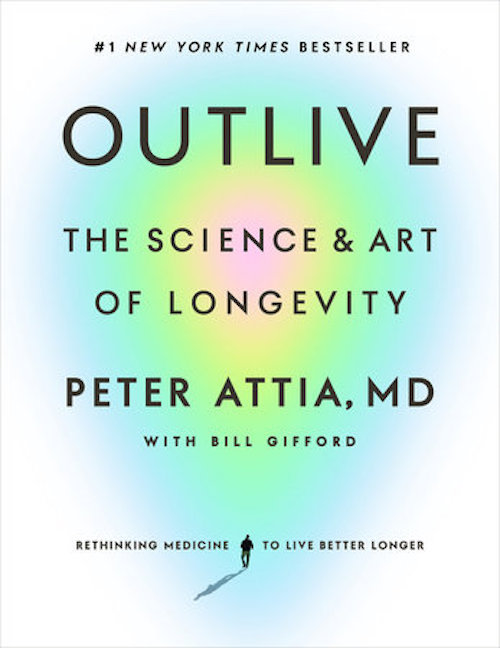Review of Peter Attia’s recent book, with Bill Gifford, OUTLIVE: THE SCIENCE & ART OF LONGEVITY, (New York: Harmony Books, 2023), $16.24.
Auburn, Al. (Special to Informed Comment) – Peter Attia, M.D. received his medical degree from Stanford University School of Medicine and trained at John Hopkins Hospital in General Surgery and worked at the NIH as a surgical oncology fellow at the National Cancer Institute focusing on immune-based therapies for melanoma. Bill Gifford, a veteran journalist, authored the N.Y. Times bestseller Spring Chicken: Stay Young Forever (or Die Trying). Each of us will one day die. There are two aspects to longevity: first, your chronological lifespan and two, your “healthspan” or how well you live. Most people die as result or effect of the “Four Horsemen,” or chronic diseases, viz., heart disease, cancer, neurogenerative disease (or type 2 diabetes) and related metabolic dysfunction.
Peter Attia (P.) argues that there are three periods or eras in medical history. Medicine 1.0 lasted two thousand years after the death of Hippocrates and dealt with observation and guesswork. Medicine 2.0 has seen its finest hour with fighting COVID-19 yet has made meager progress against what P. names the four Horsemen (heart disease, cancer, metabolic dysfunction, and metabolic syndrome including diabetes and neurodegenerative diseases like Alzheimer’s). Medicine 3.0 suggests that we have an early screening for various diseases. For example, we need to deal with cancer on three fronts: early prevention, more defective and targeted treatments, and accurate and comprehensive detection. The problem is this: we know very little about how cancer begins and why it spreads. In sum, cancer is not one, simple disease, but a condition with “mind-boggling complexity.” Yet, despite hundreds of billions of dollars spent on research on cancer, death rates have barely moved. We are intervening at the wrong point in time, i.e., well after the disease has progressed. Most diseases have been in our body for several years before they have been detected.
The main question in this book is this: how can we reduce our risk for disease and death, plus upgrading the quality of our lives as we age? In evaluating new patients, P. asks these basic questions: do we take in too many or two few calories? Are we adequately muscled or under muscled? Are we metabolically healthy or not? If we want to live a long life, we need a tactical plan. P. suggests these five dimensions: exercise, nutrition or diet, sleep, techniques to improve our emotional health, and various supplements, drugs, and hormones or molecules we take in from outside our body. Limitations of space allow me to speak to only three of these dimensions, viz., exercise, nutrition and sleep.
Exercise has the greatest power to determine how one will live out the rest of one’s life. Why so? Exercise retards the onset of chronic diseases, reverses physical decline, gives one more energy, and reverses cognitive decline. Doctors measure cardio-respiratory fitness in terms of VO2 max which is the maximum rate at which one uses oxygen. The good news is this: VO2 max can be increased by training. It’s especially important to strengthen one’s muscles. As a diabetic, I lift weights at the gym four times a week. I also walk vigorously seven days a week and avoid sugar and avoid eating pasta, rice, and heavy carbs. I take no medicine to control my diabetes. The last time I checked my HbA1C score was 5.9. At age 82, I can do twenty-five pushups and can walk with a forty-pound dumbbell in each hand for five minutes. Exercise acts like a drug in that it tells one’s body to produce its own endogenous drug like chemicals. Having strong muscles delays death because it preserves “healthspan” (or the quality of one’s life), as opposed to one’s life span.
Peter Attia with Bill Gifford, OUTLIVE: THE SCIENCE & ART OF LONGEVITY, (New York: Harmony Books, 2023). Click here.
Nutrition has several easy rules. One must eat essential fats, obtain the vitamins and minerals one needs, avoid fructose heavy foods (that likely cause blood- glucose spikes), eat fish, cut down on calories, and avoid pathogens like E. coli and toxins like lead or mercury. No dose of alcohol is healthy; hence I drink one or two bottles of Budweiser Zero Alcohol daily. One should also eat 50 grams of fiber each day. Foods high in protein like eggs have no effect on blood sugar. There’s no one diet for everyone. It depends on one’s health and one’s individual needs. Excess calories contribute to heart disease, cancer, metabolic disorders like diabetes, and Alzheimer’s disease.
Sleep is undoubtedly the best medicine for one’s brain. Our brain works well when we are unconscious as we process memories, thoughts and emotions, hence dreams. Sleep influences one’s memory, cognitive function, and emotional equilibrium. Sleep also staves off Alzheimer’s disease. P. suggests we sleep between seven and a half to eight- and one-half hours a night. One night of bad sleep has a negative effect on our physical and cognitive performance and wreaks havoc on our metabolism. Sleep deprivation increases insulin resistance by up to a third. Higher stress levels make us sleep poorly and cause glucose to be released from the liver. Less than six hours of sleep is associated with a 20 percent higher risk of a heart attack. Chronic bad sleep causes dementia and Alzheimer’s disease. P. notes that alcohol impairs sleep quality more than any other factor. Trazadone works well to help one sleep. The exact dose depends on the individual. Fifty milligrams or even less improves one’s sleep quality without grogginess the next day.
In sum, I give high marks to this study by P. He gives us forty pages of references and a helpful index. In sum, this book took my breath away. Highly recommended!
Credit: Source link




